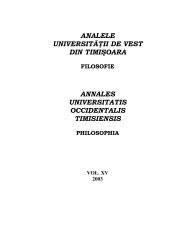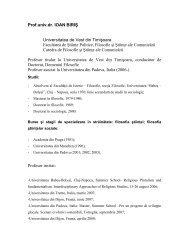VOL. IV (XXI) 2009 - Departamentul de Filosofie si Stiinte ale ...
VOL. IV (XXI) 2009 - Departamentul de Filosofie si Stiinte ale ...
VOL. IV (XXI) 2009 - Departamentul de Filosofie si Stiinte ale ...
Create successful ePaper yourself
Turn your PDF publications into a flip-book with our unique Google optimized e-Paper software.
OANA BARBU 87<br />
text is accompanied by a visual dimen<strong>si</strong>on that opens the perspectives of<br />
interpretation, the accommodation to the product being facilitated once we<br />
familiarize ourselves with it on a sensory level.<br />
Revi<strong>si</strong>ting Lakoff's perspective, based on the fundamental i<strong>de</strong>a that<br />
metaphors are conceptual rather than purely linguistic phenomena, it has been<br />
stated that they mustn't be and in<strong>de</strong>ed are not limited to verbal expres<strong>si</strong>ons.<br />
Metaphors can be expressed visually through images, either static, as in the case<br />
of magazine adverts or billboards, or moving, as with commercials and movies.<br />
These expres<strong>si</strong>on mo<strong>de</strong>s can be combined with all of the five senses (<strong>si</strong>ght,<br />
hearing, touch, smell, taste etc.) in or<strong>de</strong>r to ren<strong>de</strong>r pos<strong>si</strong>ble the construction and<br />
interpretation of metaphors in a pictorial or even a multimodal manner.<br />
Following Lakoff's explanation of the linguistic context created by the use<br />
of metaphor in everyday language, we might argue that adverti<strong>si</strong>ng slogans<br />
function from a contemporary standpoint as trans-cultural metaphors. If, as we<br />
have shown, the rhetorical structure of metaphors re<strong>si</strong><strong>de</strong>s and functions in a<br />
complex network of <strong>si</strong>gns and socio-cultural meanings, adverti<strong>si</strong>ng slogans<br />
manage to convey concepts and i<strong>de</strong>as regardless of social and cultural<br />
barriers, liberalizing the meanings through the use of metaphor as a gui<strong>de</strong>. We<br />
often use in our everyday language adverti<strong>si</strong>ng slogans as metaphors to aid<br />
us in getting through an i<strong>de</strong>a to our communication partners; familiar to a large<br />
audience, their integration in our interactions facilitates the un<strong>de</strong>rstanding of<br />
the communicated contents, so much so that if we wish to express courage,<br />
we can ea<strong>si</strong>ly achieve this by resorting to the Nike slogan - Just do it!.<br />
Of image and other daemons<br />
Noteworthy for this discus<strong>si</strong>on is the strong link between the text and the<br />
adverti<strong>si</strong>ng image as a metaphor generator. The adverti<strong>si</strong>ng discourse initially<br />
presents itself as an unstable, hybrid structure in which the balancing of text and<br />
images is ma<strong>de</strong> in an uncontrollable manner. Second most influential for the<br />
consumers, though extremely vi<strong>si</strong>ble in everyday language, the linguistic<br />
<strong>si</strong>gnifier emerges within the adverti<strong>si</strong>ng discourse as several textual constructs:<br />
logo, slogan, body text, each serving the adverti<strong>si</strong>ng discourse by <strong>si</strong>mple way of<br />
the fact that any adverti<strong>si</strong>ng argumentation begins with its vi<strong>si</strong>bility.<br />
From the typography layout within the page, <strong>de</strong><strong>si</strong>gned to grab the<br />
attention, to the aesthetic construction of the logo, inten<strong>de</strong>d to create/increase<br />
brand memorability, the pragmatic characteristic of most of adverti<strong>si</strong>ng texts is<br />
its sustainability, with the attention directed towards the visual-figurative whole.<br />
This indicates that even the construction of the adverti<strong>si</strong>ng text abi<strong>de</strong>s by the<br />
outline of the visual and the visual metaphor which generates new meanings:<br />
specific typefaces for the logo and slogan, specific colors and textures for the<br />
letters, different orientation of text within the page, all of these draw attention<br />
on the importance of adverti<strong>si</strong>ng visual rhetoric, as we will try to show.<br />
"Weather we like it or not, each of us experiences at the present time a<br />
crack within the representation of the world and so, its reality. The split




